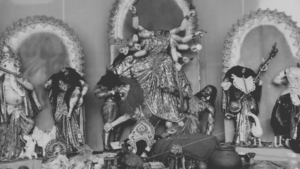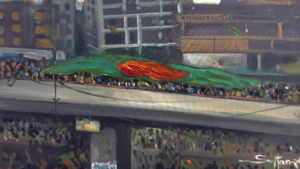
Artist: Sultan Ishtiaque
Share the post "Viewing Bangladesh’s popular uprising as ‘U.S. Regime-Change Operation’ is misleading"
In a recent article titled Accusations of US Regime-Change Operations in Pakistan and Bangladesh Warrant UN Attention, Jeffrey D. Sachs, Professor and Director of the Center for Sustainable Development at Columbia University, drew parallels between the demise of Bangladesh’s Prime Minister Sheikh Hasina and the ouster of Pakistan’s Prime Minister Prime Imran Khan, suggesting U.S. involvement in both events. He even called for a UN investigation into U.S. involvement.
He describes the recent developments of Bangladesh as part of the U.S. involvement in ‘regime-change operations’ and ‘toppling governments around the world’ throughout history.
While it is undeniable that various external forces influence movements or upheavals worldwide, Gene Sharp, a long-time scholar of non-violent civil disobedience, emphasized that the role of external forces in a movement can only be altered when resistance against dictatorship is built from within.
Those who once supported a dictator may even switch sides and back the movement if strong resistance persists within the country. Thus, the involvement of external forces or superpowers does not negate the legitimacy of the movement itself.
However, Jeffrey Sachs turns his entire narrative into a conspiracy theory by presenting half-truths, comparing disparate events (Bangladesh vs Pakistan), and relying on unreliable sources in his writing about U.S. involvement.
Sachs compares the developments in Bangladesh with the ouster of Imran Khan in Pakistan. While Imran Khan’s removal was marked by high political drama and constitutional chaos, Sheikh Hasina’s fall resulted from the largest popular uprising in Bangladesh’s history.
The nature of the two events and the impact of any external force on parliamentary tension and popular uprisings are naturally different. Yet, Sachs’ writing implies that Hasina and Imran were ousted similarly.
Sachs claims that, ‘… Sheik Hasina fled to India following a violent coup in her country… PM Hasina was ostensibly toppled by student unrest, and fled to India when the Bangladeshi military refused to prevent the protestors from storming the government offices.’
This could lead readers to believe there was a violent coup against Hasina, with the military aiding the agitators, hinting at a military coup. But this is an utter lie.
In reality, the student movement that finally overthrew the Hasina regime was not violent. When students initiated their street protest against job discrimination in July, law enforcement forces like police, BGB along Awami League activists brutally repressed them, killing over 500 protesters within only 10-15 days.
The massacre of the Hasina regime turns the student movement into a mass movement. When Sheikh Hasina attempted to use more force against the protesters, the military expressed reluctance to do so and instead supported the movement.
The overwhelming support for the movement forced the military to side with the students and people.
In this context, Sheikh Hasina was compelled to flee the country, and an interim government was formed based on the recommendation of the protesters.
Jeffrey Sachs’ writing fails to acknowledge the political reality of Bangladesh for the last decade. Many researchers have systematically documented the country’s democratic backsliding and drift toward autocracy. Bangladesh has witnessed a culture of fear, suppression of freedom of speech, imprisonment, enforced disappearances, and extrajudicial killings.
There are numerous allegations of corruption, including money laundering, against Sheikh Hasina’s regime. The popular uprising that began in July was a response to this long-standing democratic decline and oppressive autocratic rule.
Additionally, researchers have long pointed to India’s role in supporting Bangladesh’s autocracy and keeping Sheikh Hasina in power.
Even the autobiography of former Indian President Pranab Mukherjee acknowledges India’s involvement in Bangladesh’s elections. India also played a decisive role in the 2024 elections which is widely regarded as a ‘dummy’ and ‘sham’ election by the analysts.
Jeffrey Sachs’ article does not mention the dictatorship in Bangladesh, the popular anger against it, or India’s role. He even quoted a statement by Hasina claiming that ‘The U.S. removed her from power because she refused to grant the U.S. military facilities in a region that is considered strategic for the U.S. in its “Indo-Pacific Strategy” to contain China’.
This statement was false, as confirmed by Hasina’s son in a counter-statement.
As a result, Jeffrey Sachs’ article turns into a conspiracy theory, filled with half-truths, fake news, and uneven comparisons.
In his search for U.S. involvement in the fall of Hasina, he effectively undermines the legitimacy of Bangladeshi people’s non-partisan spontaneous resistance against dictatorship and disregards their agency in the process.





